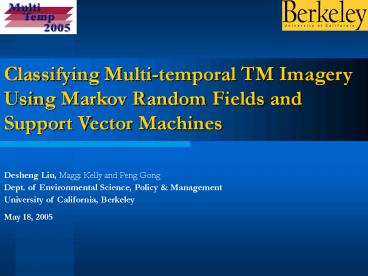Desheng%20Liu,%20Maggi%20Kelly%20and%20Peng%20Gong - PowerPoint PPT Presentation
Title:
Desheng%20Liu,%20Maggi%20Kelly%20and%20Peng%20Gong
Description:
Estimation of conditional probability. Maximum Likelihood Classifier (MLC) ... of the conditional prior probability of ... Iterative Conditional Mode (ICM) ... – PowerPoint PPT presentation
Number of Views:49
Avg rating:3.0/5.0
Title: Desheng%20Liu,%20Maggi%20Kelly%20and%20Peng%20Gong
1
Classifying Multi-temporal TM Imagery Using
Markov Random Fields and Support Vector Machines
Desheng Liu, Maggi Kelly and Peng Gong Dept. of
Environmental Science, Policy
Management University of California, Berkeley May
18, 2005
2
Outline
- Introduction
- Two aspects of Multi-temporal Imagery
- Classification Models
- Methods
- Support Vector Machines
- Markov Random Fields
- Spatio-temporal Classification
- Results
- Conclusions
3
Two Aspects of Multi-temporal Imagery
Introduction
T
- Spatial Dependence
- Pixels are not I.I.D.
- Spatial Autocorrelation
- Temporal Correlation
- Land Use
- Phenology
- Disturbance
Y
X
4
Classification Models
Introduction
- Non-contextual Model
- Contextual Models
- Spatial
- Temporal
- Spatio-temporal
5
Generative Spatio-temporal Models
Introduction
- Estimation of conditional probability
- Maximum Likelihood Classifier (MLC)
- Support Vector Machines (SVM)
- Modeling spatio-temporal context
- Markov Random Fields (MRF)
6
Methods
SVM A Graphic View (1)
- Linear Cases find the optimal linear separating
boundary with (a) maximum margin ? (b) best
trade-off between maximum margin ? and
minimum classification errors ?
(a)
(b)
7
Methods
SVM A Graphic View (2)
- Non-Linear Cases find the optimal linear
separating boundary in a transformed higher
dimensional feature space
F(x)
8
SVM A Mathematic View (1)
Methods
Binary Cases
- Training samples
- Decision function
- Discriminant function
- Linear cases
- Nonlinear cases
- Probability output
9
SVM A Mathematic View (2)
Methods
Multi-category Cases
- Combination of binary SVM
- One-versus-one
- One-versus-all
- Probability output
- Pairwise coupling of binary probability outputs
- Soft-max function
10
Markov Random Fields
Methods
- Markov Random Fields (MRF) --- Probabilistic
image models which define the inter-pixel
contextual information in terms of the
conditional prior probability of a pixel given
its neighboring pixels
11
MAP-MRF
Methods
- Bayes Decision Rule Maximum a posterior (MAP)
- MAP-MRF the joint formulation of MAP and MRF
MAP-MRF
12
Spatio-temporal Classification
Methods
Conditional Probability
Conditional Prior
Markov Random Fields
Support Vector Machines
MAP-MRF
13
Methods
Implementation Algorithm
Iterative Conditional Mode (ICM) iteratively
estimate the class label of each pixel given the
estimates of all its neighbors
14
Data and Study Site
Results
TM Imagery of June 11, 1997
San Bernardino National Forest, CA
15
Data and Study Site
Results
San Bernardino National Forest, CA
TM Imagery of June 10, 2002
16
Classification Flow
Results
17
Results
Training/Test Samples
18
Classification Accuracies of TM 1997
Results
19
Classification Accuracies of TM 2002
Results
20
Convergence Rate
Results
21
1997
Results
MLC-Spatio-Temp
Original Image
MLC
SVM-Spatio-Temp
SVM
22
2002
Results
23
Conclusions
- SVM are much better in the processing of spectral
data than MLC for the initialization of the
iterative algorithm. - MRF are efficient probabilistic models for the
analysis of spatial / temporal contextual
information. - The combination of SVM and MRF unifies the
strengths of two algorithms and leads to an
improved integration of the spectral, spatial and
temporal components of multi-temporal remote
sensing imagery.
24
Acknowledgements
- USDA Forest Service
- NASA Earth System Science Graduate
Student Fellowship
25
(No Transcript)































